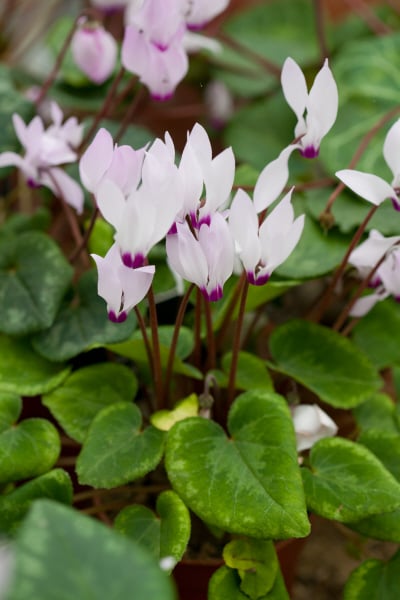Cyclamen persicum
Persian cyclamen
A winter or spring-flowering tuber, growing to 10-20cm in height. Heart-shaped, dark-green leaves have silver markings. Fragrant white or pink flowers with petals swept upwards have carmine mouths
Size
Ultimate height
0.1–0.5 metresTime to ultimate height
2–5 yearsUltimate spread
0.1–0.5 metresGrowing conditions
Moisture
Well–drainedpH
Acid, Alkaline, NeutralColour & scent
| Stem | Flower | Foliage | Fruit | |
| Spring | Pink White | Green Grey Silver | ||
|---|---|---|---|---|
| Summer | ||||
| Autumn | Green Grey Silver | |||
| Winter | Pink White | Green Grey Silver |
Position
- Full sun
- Partial shade
Aspect
South–facing or East–facing or West–facing
Exposure
Sheltered Hardiness
H1CBotanical details
- Family
- Primulaceae
- Native to GB / Ireland
- No
- Foliage
- Deciduous
- Habit
- Tufted
- Potentially harmful
- Ornamental bulbs, not to be eaten. Wear gloves and other protective equipment when handling Pets: Ornamental bulbs, not to be eaten - see the HTA guide to potentially harmful plants for further information and useful contact numbers
- Genus
Cyclamen are tuberous perennials with rounded, sometimes angular, leaves which are often attractively mottled. The nodding, characteristically shaped flowers have 5 reflexed and twisted petals, often with dark markings at the base
- Name status
Correct
- Plant range
- E Mediterranean
How to grow
Cultivation
Grow indoors or under glass in containers of peat-free, loam-based compost with the tops of the tubers just above the soil surface. Maintain bright filtered light with moderate humidity and a minimum winter temperature of 13 to 16°C. Avoid draughts and hot dry air. When in growth water moderately and apply a low nitrogen liquid fertiliser fortnightly. Reduce water after flowering and keep dry when dormant
Propagation
Propagate by seed, in darkness as soon as ripe at 12 to 15°C. Can be beneficial to soak seed for 10 hours prior to sowing
Suggested planting locations and garden types
- Houseplants
- Patio and container plants
- Conservatory and greenhouse
Pruning
No pruning required
Pests
May be susceptible to mice and squirrels, and to vine weevil when grown in containers
Diseases
May be susceptible to cyclamen grey mould and black root rot
Get involved
The Royal Horticultural Society is the UK’s leading gardening charity. We aim to enrich everyone’s life through plants, and make the UK a greener and more beautiful place.
